5 Beautifully Sustainable End-Grain Wood Cutting Boards
Ditch the plastic.
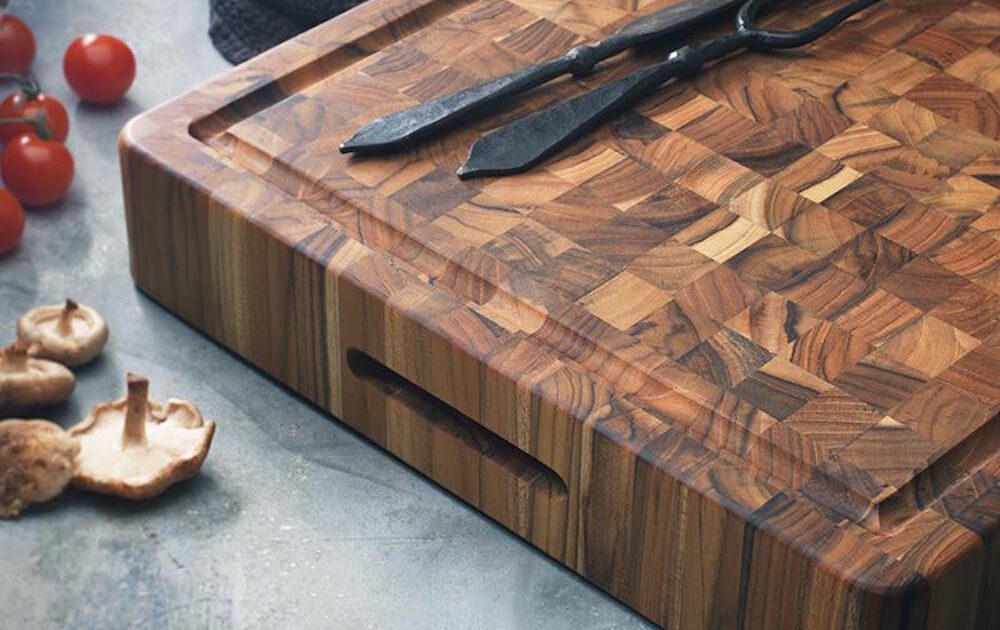
*Affiliate Disclaimer
When it comes to buying cutting boards, things can be a bit confusing. After all, there’s nothing more beautiful than a wooden cutting board, but those things are breeding grounds for bacteria… right? Well, the truth is a bit more complicated, but to make a long story short, it’s perfectly safe to slice and dice on wood – and it may even be better for you than plastic.
Edge-Grain vs End-Grain
Aside from the variety of wood being used, one of the most important decisions to make when choosing a wood board is how it’s made. Two major types of assembly are used in the wooden cutting board industry: end-grain and edge-grain.
Edge-grain, as its name suggests, is made of parallel pieces from the edge of the wood. More durable and easier to maintain, edge-grain cutting boards are also more affordable. However, edge-grain can also be harder on knives, due to the way in which wood fibers are laid out.
“Probably the easiest way to picture wood fibers in a board is to think of them as a bundle of soda straws,” says John Loftis of The Boardsmith. “The wood fibers are actually hollow, like drinking straws, and when you have an edge-grain board, those straws would be visualized as lying lengthwise.”
When cutting, then, your knife damages the fibers, creating scratch marks – something that Loftis notes are “the enemy of any cutting board, because scratch marks and knife-marks are places where bacteria can hide.”
End-grain wood is the favorite for most pros. These boards are made from end pieces of wood that are glued together, often in a checkerboard pattern. With end-grain, Loftis explains, you can imagine the “straws” of the wood fibers being turned vertically.
“What happens when the knife chops or strokes on them is that it goes between these individual straws, and the straws bounce back together,” he explains. “So there’s a tremendous amount of resistance of scratching and storing.”
This layout also allows bacteria-laden moisture to wick down into the board itself. “In essence,” says Loftis, “It’s sealed off and the bacteria dies.”
An end-grain board is also easier on your knife, preserving these all-important tools in your kitchen arsenal.
Plastic vs. Wood: Which to Choose?
Plastic cutting boards are touted for their cleanliness and the ease of their care: all you need to do to wash one is run it through the dishwasher. People also tend to assume that because wood is porous and plastic isn’t, it’s more sanitary.
Research from Dr. Dean Cliver at the University of California, Davis, disproved this line of thinking. He found that since plastic boards are easily scarred by knives (whereas a well-made wooden board is soft enough to not be damaged by knife use), they can become breeding grounds for bacteria, which congregate in the grooves formed by blades.
“Wooden boards that had been used and had many knife cuts acted almost the same as new wood, whereas plastic surfaces that were knife-scarred were impossible to clean and disinfect manually, especially when food residues such as chicken fat were present.”
In addition, even though plastic surfaces “allowed the bacteria to persist, but were easily cleaned and disinfected,” bacteria “were not recoverable from wooden surfaces in a short time after they were applied.”
The Right Type of Wood
When you’re choosing a wooden cutting board, there are a few things to bear in mind.
The first is the species of wood being used.
“As a general rule, it’s preferable to select a hardwood, as it is hardier and will hold up better over time,” explains Grant Yuan, president of CuttingBoard LLC. “Soft woods, such as pine or fir, don’t hold up to knives and washing well and will wear much faster as a result.”
Common hardwoods include cherry and walnut; maple, he notes, is the most popular for its durability and for its abundance in North America, making it cheaper than some others.
“Teak is also becoming popular,” he notes. “Which makes sense because teak has been used in marine applications due to its abilities to resist harsh outdoor weather environments.”
You’ll also want to look into the sustainability of the source materials.
“The good thing about wood boards is that the vast majority are renewably grown and harvested,” Yuan notes. “Domestic North American woods such as maple, cherry and walnut are all plentiful and eco friendly.”
Water Proof vs Heat Resistant Glue
Whichever board you use, it’s also important to stay away from glues that contain formaldehyde. Most of the boards that we recommend use either Titebond II or Titebond III food-safe glues. The latter is a waterproof glue; the former, while not waterproof, is water-resilient, and it withstands high heat better.
Rick Odea of Richard Rose Culinary notes that he uses type III for boards destined for home use.
“I know that someone is gonna submerge it or run it under water, and I want those joints to stay laminated,” he explains.
He usually opts for type II for restaurants, because of the glue’s resistance to high heats.
“We do a lot of pizza boards,” he says. “I don’t want the glue to be broken down by high heat, so tight bond II is the better choice.”
Depending on what you will be using your board for and how you intend to care for it, this is a good question to ask the manufacturer before buying a board.
Our 5 Favorite End-Grain Cutting Boards
Here are our editor’s favorite sustainably sourced and beautifully crafted end-grain cutting boards.
1. TeakHaus End-Grain Teak Cutting Board
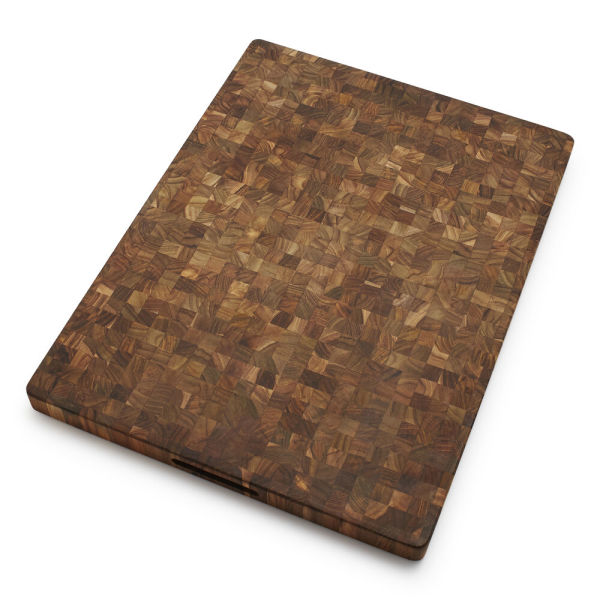
From 12/11 to 12/14: Take 25% off with code “COOKIE20”.
Teak is an excellent, durable choice for cutting boards thanks to its natural resistance to moisture, and FSC-certified TeakHaus is committed to making these boards environmentally sustainable as well, planting teak forests in previously undeveloped lands.
“TeakHaus products combine fashion with sustainability,” explains the company. “Our boards are ready-made, stylish, long-lasting and perfect for every cooking moment.”
The beautiful butcher block collection of end-grain cutting boards offers a variety of shapes and sizes to suit your specific needs.
2. John Boos End-Grain Cutting Board
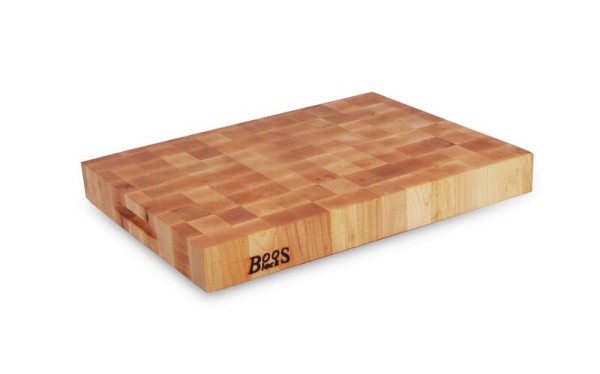
John Boos has long been one of the top names in American-made wooden cutting boards. Established in 1887, John Boos works with three American hardwoods – hard rock maple, cherry, or black walnut – for solid, durable boards that stand the test of time.
John Boos is also a sustainable choice, boasting the National Hardwood Lumber Association certification.
“Our butcher block wood is sourced and responsibly harvested,” explains John Boos rep Mandy Ruholl-Cook. “No scrap goes to waste. We use every piece in our product and what is left over we grind into sawdust to fuel our boilers and dry kilns to dry our lumber.”
3. Michigan Maple Block
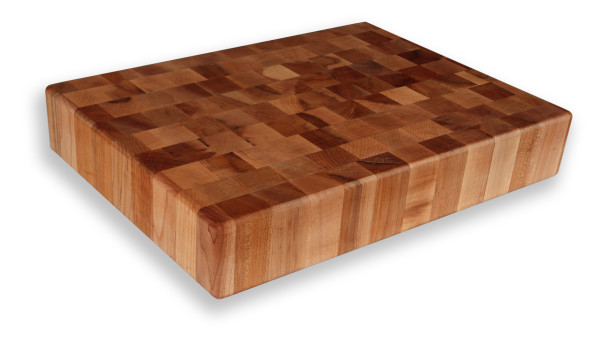
Michigan Maple Block is yet another traditional cutting board maker, founded in 1881. The company takes particular pride in its eye towards sustainability: a forest stewardship team manages the company-owned tracts of land from which the wood is harvested, and scraps and sawdust generated in the production process are used to heat the plant and fire kilns.
“We source generally from within a 200 mile radius of the plant,” explains Barbercheck. “This keeps the use of fuel to a minimum.”
This also ensures that the woods have a particularly tight grain, he notes, due to the long, cold winters in the area.
“This tight grain distinguishes us even from other wood cutting boards,” he says.
4. Catskill Craftsmen End-Grain Cutting Board
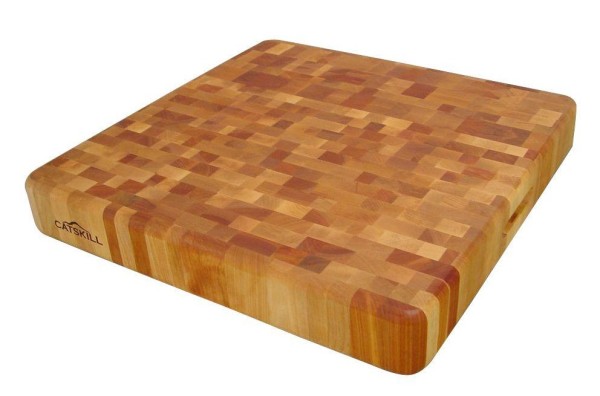
This rural New York-based manufacturer has been making hardwood kitchen islands, carts, and work-centers since the 1940s and today is one of the top producers of quality end- and edge-grain cutting boards made from sustainable North American, non-endangered hardwoods like birch and hard rock maple.
“Lumber is purchased from area sawmills, then dried, manufactured, and packaged on site,” explains the company. “All sawdust, shavings and waste materials generated during the manufacturing process is converted into wood pellet fuel, and used to heat homes. We are proud to say, ‘Our operations generate no wood waste.’”
Catskill Craftsmen went even further in its sustainability goals in 1997, when the company teamed up with the Watershed Agricultural Council to install an air recirculation system to take advantage of the warm air in the plant, lowering wintertime heating costs substantially.
Many of Catskill Craftsmen’s boards are thicker slabs with finger slots, making them both sturdy to use and easy to manage and maneuver. They offer both reversible boards and boards with feet; the former are great for separating meat and plant-based cutting surfaces, while the elevated surface of the latter is great for ensuring that your board does not absorb too much moisture while you work.
5. Ironwood Gourmet End-Grain Cutting Board
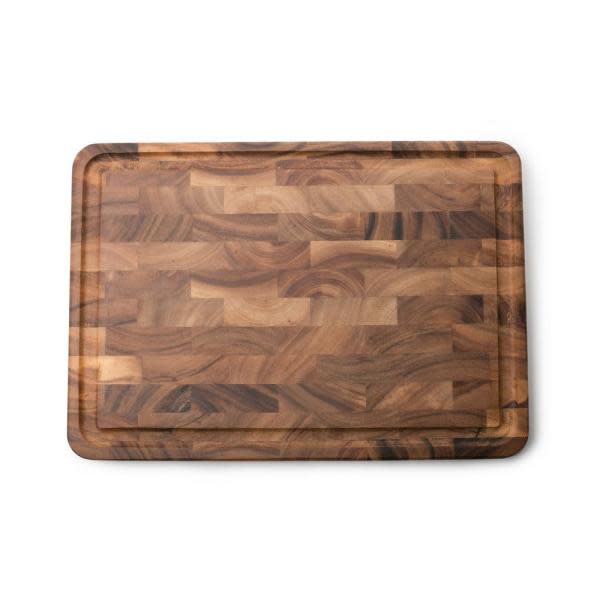
The unique patterns of Ironwood Gourmet’s acacia and rubberwood boards make these pieces as beautiful as they are useful.
Acacia is an environmentally friendly wood that is known for its rich, dark colors and its unusual chatoyancy, a property that makes it appear to change color and luster in different lighting conditions. Rubberwood, meanwhile, is an eco-friendly wood that is durable and less likely to warp and crack than other woods and sourced from latex-producing rubber trees that are between 26 and 30 years old. At this point, latex yields become low, and planters usually fell the rubber trees to make way for new ones.
“Unlike other woods that are cut down for the sole purpose of manufacturing,” explains the company, “Rubberwood is used only after it completes it’s latex-producing cycle and dies. This wood is therefore eco-friendly in the sense that we are now using what was going as waste.”
Taking Care of Wood Cutting Boards
Wooden cutting boards require slightly more care than their plastic counterparts, but if you treat a wooden cutting board right, it will last you a lifetime.
As with any cutting board, it’s important to be aware of what you’re cutting and in what order. While wooden cutting boards do wick away bacteria, to avoid cross-contamination, it’s a good idea to chop vegetables before meat or poultry. With a two-sided cutting board, you could also use one side for meat or for strong-smelling garlic and onions and the other side for everything else.
Care-wise, wooden cutting boards should never be put in the dishwasher; they also should not be washed under a stream of running water. Wash your cutting board quickly with dish soap, rinse it, and dry it off before putting it away.
“Because wood is still naturally living, it expands and contracts,” explains Odea. “And eventually, if it gets really soaked, the board will absorb all this water, and then as it dries out, that’s where cracks happen.”
It’s a good idea to regularly treat your board with oil – Yuan suggests every two to three months. “When a wood board isn’t properly maintained, the wood becomes overly dry and can split or crack as a result,” he says. “Paradoxically, a dry cutting board is also most likely to warp, as water will cause the dry wood fibers to expand and cup (curl) when wet.”
While many board manufacturers also make their own board oil, we like Caron & Doucet vegan cutting board oil, which is made with coconut oil and devoid of petroleum byproducts. It is refined to be flavorless and odorless, and not to go rancid like other oils. The blend also includes essential oils, lending the product a scent reminiscent of pine and citrus.
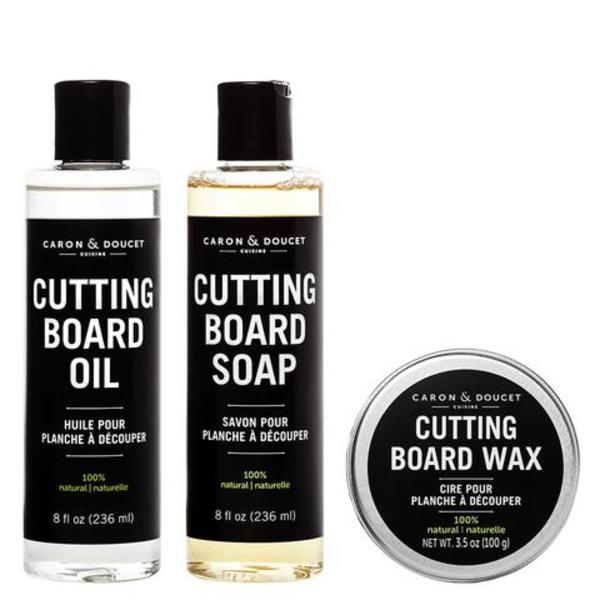
In addition to regular oiling, most experts also recommend using some sort of conditioning cream, usually made with beeswax, to serve as a natural water repellant. Caron & Doucet also makes a vegan board wax, which you can use in tandem with the natural oil to keep your board looking like new.
Help support Organic Authority! Our site is dedicated to helping people live a conscious lifestyle. We’ve provided some affiliate links above in case you wish to purchase any of these products.
Related on Organic Authority
How to Clean Wooden Cutting Boards
11 Fabulous Gifts for Your Conscious Foodie Friends
How to Make Sure Your Wood Furniture is Sustainable

